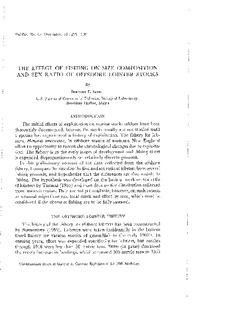| dc.description.abstract | The lobster fishery in the offshore waters of southern New England
is in the early stages of development. The assumption that canyon fishing
grounds closest to shore are the most heavily fished was supported by a
lower catch per day (CPE), a smaller mean size, and a higher total
mortality than exists in more distant canyons.
At Hudson and Veatch Canyons, less than 250 km offslzore, the average
CPE was 552 kg; Oceanographer and Lydonia Canyons extend 300 km
offshore and had a CPE of 670 kg; and at Corsair Canyon, which is
400 km from shore, CPE was 741 kg. Lobsters were smallest at the canyons
wllicll were closest to shore and had the lowest CPE. The size frequency
was higher at the canyons of intermediate distance and the CPE was
higher. The largest lobsters were from Corsair Canyon, which is the
furthest from shore, and had the highest CPE.
The modal carapace length of lobsters at Veatch Canyon was over
12 em in 1956 and is now less than 9 cm. In three successive years of
Data provided by JAMES THOMAMSa,i ne Department of Sea and Shore Fisheries.
sampling (1965-67), the contribution of small lobsters has increased and
in 1967 more than 90 percent of the legal-sized lobsters were from the
8 to 10 cm length class. The progressive change at Veatch Canyon and
magnitude of size differences among canyons are greater than expected
from the influence of temperature or depth of fishing.
Observed changes in sex ratio support the basic assumptions made
in THOMA(S19' 55) model and follow the expected changes at different
levels of mortality. The proportion of females to males increases
gradually from 8 cm to 13 cm and then declines. Because females molt
less frequently than males, their numbers at a given size decline more
rapidly. The model assumes that females molt only every two years;
whereas, males molt annually and have a lower intermolt mortality.
The change in sex ratio was used to estimate mortality in the offshore
fishing grounds. The more distant canyons had a lower mortality, higher
catch per unit of effort, and larger size composition. The size composition
and sex ratio of coastal lobster fisheries indicated that exploitation was
more intense than in offshore fisheries.
The increased proportion of young lobsters in the offshore catches
followed expected changes from exploitation, but also suggested an
increase in the population birth rate. This possibility was supported
by the observation that in ten years the percentage of berried females at
smaller sizes of maturity had increased substantially. However, additional
data are needed to determine whether the improved recruitment has
resulted from other factors.
Additional data and analyses are needed to test the hypothesis that
fishing has caused the changes in size composition, sex ratio, and catch
rates. If the assumptions hold and the level of fishing continues or increases,
the more distant canyons are expected to experience changes in
lobster size, sex ratio, and catch rates-comparable to those at the
canyons closest to shore.
The size at maturity, frequency of molting, and rate of growth used
in the model are not entirely consistent with observations in the offshore
fishery. However, the basic concepts seem applicable and the necessary
adjustments and corrections can be incorporated into the model
when sufficient data are available. | |
